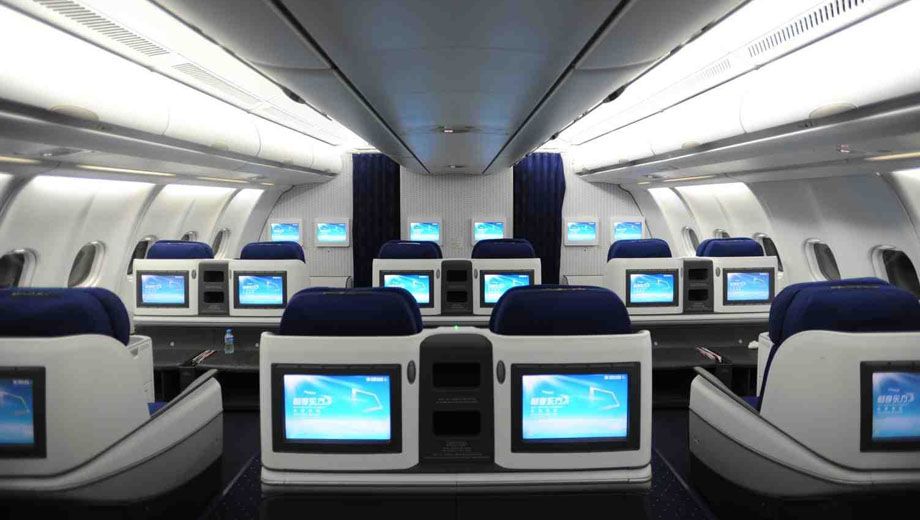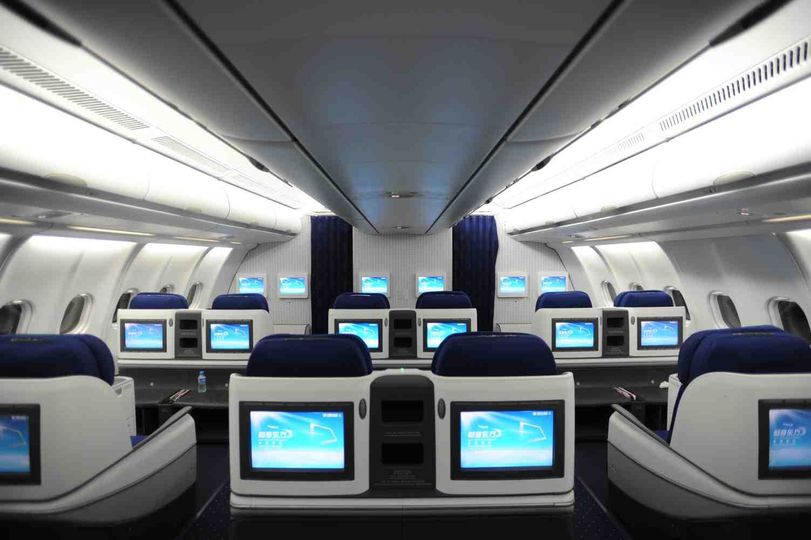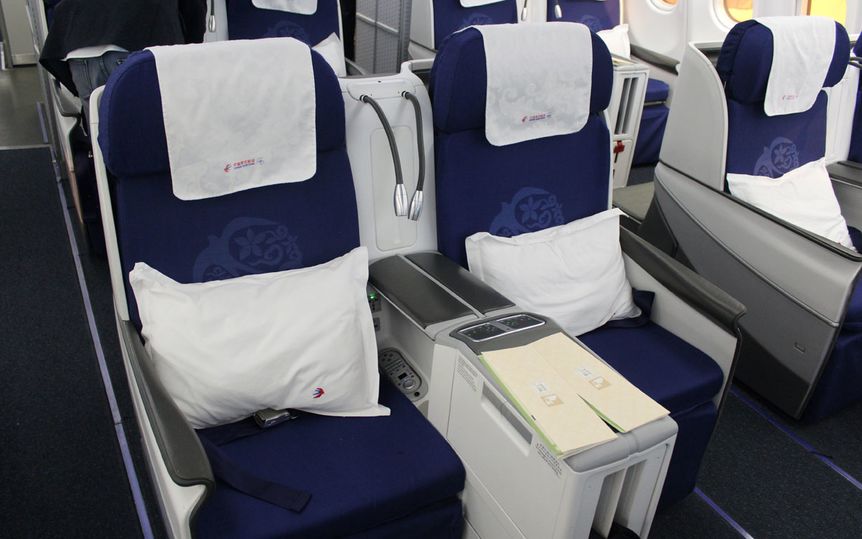Review: China Eastern Airbus A330 business class (Shanghai-Brisbane)

Route
Shanghai (Pudong) - Brisbane
Aircraft Type
Airbus A330-200
Airline
China Eastern
Flight
MU715
Cabin Class
Business
Seat
6L (window)
Notes
The Good
- Complimentary chauffeur service, if booked far enough in advance
- Full dinner and breakfast served on overnight flights
- Fully-flat beds (although not universal direct aisle access)
The Bad
- 2-2-2 seating layout
- Service could be better-refined
- Headphone quality: BYO is best
X-Factor
- Non-stop flights between Brisbane and Shanghai, which certainly beats connecting in Sydney
Introduction
When jetting to Shanghai, Queensland residents no longer need to add hours to their travel time with a connection via Sydney as in yesteryear, with Qantas partner China Eastern offering year-round non-stop flights between Brisbane and China's financial capital.
Using an A330 aircraft with fully-flat beds – but without the common pairing of universal direct aisle access – Executive Traveller stepped on board China Eastern's Airbus A330-200 business class to bring you this review.
Check-in
- Frequent flyer program: Eastern Miles, SkyTeam, but as a Qantas Frequent Flyer partner airline, travellers can choose to earn and redeem Qantas Points on China Eastern MU-coded flights, and can also earn Qantas status credits on Qantas codeshare flights operated by China Eastern.
- Checked baggage allowance: 2x32kg bags, increased to 3x32kg for Eastern Miles Silver, Gold and Platinum members and other SkyTeam Elite and Elite Plus frequent flyers, but tiered Qantas Frequent Flyer members receive no additional allowance.
- Carry-on baggage allowance: Technically, it's 1x10kg bag of up to 115cm, but as on my earlier Sydney-Shanghai flight, I had no issues carrying a separate laptop bag into the cabin as well, allowed as standard by most other airlines in international business class.
- Priority check-in: China Eastern business class passengers have a dedicated check-in area at Pudong Airport, but the line looked about 20-minutes deep. Fortunately, I was travelling with only carry-on baggage and was able to use a kiosk in that same area to scan my passport and obtain a boarding pass in under 60 seconds, so was quickly on my way. The kiosk is easily switched to English, and has an intuitive interface that makes it easy to add a Qantas (or other) frequent flyer number to your reservation, if you hadn't already linked one:
- Other priority services: There's no fast-track line at passport control for business class flyers although the normal queue took only a few minutes, but once you're through, head to the far right to the area marked "VIP", which offers speedier security screening for business class. However, there was no attempt at priority boarding, and all passengers (business class and economy) were transferred to the aircraft by the same bus, which was standing room only. Express Path cards were offered at the aircraft door on arrival into Australia.
- Complimentary chauffeur service: While technically offered, it's incredibly restrictive: you have to request your car online at least seven "working days" before departure – making it unusable for business travellers booking flights closer to travel day – and with each flight, you have to choose between a transfer in Shanghai or Brisbane (you can't have both). You also can't request the chauffeur when booked on a Qantas QF codeshare flight or on a flight booked using frequent flyer points, and if you need to change your chauffeur booking, you'll be up for a $150 fee: in many cases being more expensive than what you'd pay to simply book your own driver.
Lounge
China Eastern's flights to Australia depart from Terminal 1 at Pudong Airport, where there's a two-storey China Eastern business class lounge just beyond the security screening point.
I arrived a few hours before departure and found that while the downstairs area was packed, there was almost nobody upstairs, which made it a decent place to get some work done.
That said, upstairs has only a limited snack buffet with some drinks on the side – all the hot food is downstairs, including a DIY noodle soup counter.
Cafeteria-style trays are available here, which I spotted many passengers taking advantage of: heading straight to the food area upon entering the lounge and grabbing their preferred hot dishes with their bags parked nearby, before taking everything upstairs and settling in. I'll remember that tip on my next visit.
Qantas Platinum, Platinum One and Chairman's Lounge members also have access to the separate China Eastern first class lounge next door when flying with Qantas or China Eastern on a QF or MU flight number, which I'd expect to be considerably quieter.
China Eastern's Eastern Miles Gold and Platinum members can also visit that first class lounge when flying with China Eastern on an MU flight number – and on a Qantas (QF) codeshare flight operated by China Eastern, for Platinum members only – although most business class flyers will be using the standard business class lounge.
AusBT review: China Eastern business class lounge, Shanghai Pudong Terminal 1
Flight
China Eastern offers four return flights each week between Brisbane and Shanghai, running as a daytime flight from the Queensland capital and an overnight leg from China's financial hub.
On Mondays, Wednesdays, Thursdays and Saturdays, flight MU716 is wheels-up at 11am from Brisbane Airport, reaching Shanghai at 7:40pm local time after a journey of 10hrs 40min.
Returning on Tuesdays, Wednesdays, Fridays and Sundays, MU715 pushes back at 9:10pm in Shanghai, touching down in Brisbane at 9am the following calendar day with a shorter flight time of 9hrs 50min.
While Qantas Frequent Flyer members can earn Qantas Points (but no status credits) on China Eastern MU-numbered flights, status credits can be added to that parcel by booking a Qantas QF codeshare flight number instead: sold as QF5007 from Brisbane to Shanghai, and QF5006 from Shanghai to Brisbane.
China Eastern also links Sydney and Melbourne with Shanghai – which Brisbane travellers can use as a connection point on the days not serviced by MU715/716, in conjunction with a Qantas domestic flight – with seasonal flights from Cairns to Shanghai as well, and year-round service from Auckland.
Seat
China Eastern operates a variety of aircraft types with an array of different business class seats, but for the most part, Brisbane is served by the airline's Airbus A330-200 jets with a five-row, 2-2-2 configuration in business class, identified by an aircraft type of '33E' in China Eastern's booking systems.
Brisbane occasionally gets China Eastern's other Airbus A330-200s which have seating in a more favourable 1-2-1 layout, shown in booking systems with an aircraft type of '33H', but we're reviewing the '33E' Airbus A330 jet with that six-across seating in business class, which most Brisbane-based business travellers will encounter.
Naturally, this layout doesn't offer every passenger direct and uninterrupted aisle access, with those seated next to the window stepping past their aisle-side seatmate, and those on the aisle having the window passenger hopping over them.
When flying solo, my strategy is to select a seat in the centre pair which avoids that issue, but as this flight wasn't particularly full, I moved over to the window before departure: giving myself and my former seatmate more space to stretch out, with vacant seats beside us:
Each seat transforms into a fully-flat bed of approximately 190cms (75 inches), at a width of 53cm (21 inches)...
... adorned by a large pillow, and a plush blanket sizeable enough to wrap around yourself: handy even if you're warm as the bed can be made softer by lying on top of it – although there's no separate seat topper or mattress pad, and pyjamas are BYO.
As blankets are distributed shortly after take-off and with two seats at my disposal, I made up my bed over by the window and elected to dine in the aisle seat:
Each seat provides a fixed ottoman with a storage nook underneath, the top being useful as a foot stool when sitting down and forming the tail end of your bed at nap time, although with 'do not sit' markings, this can't be used as a companion seat...
... with further storage provided at the front of the centre console. This isn't visible when seated, so you do need to remember it's there and to check it before you leave the aircraft, as the design could easily result in a laptop being left onboard:
The top of that console serves as a drink and snack area, with the seat's controls nearby. While your seat position isn't as customisable as on other flights, I always appreciate being able to save and return to my preferred spot via the memory function, which is available:
You'll find an international AC outlet to your side, along with a USB charger, the headphone plug and a remote control for the inflight entertainment system:
This space is below your armrest when sitting upright, but that armrest can be raised when in bed mode to provide additional privacy – shown here with one seat lowered and the other raised – and which is particularly effective if you're seated by a window:
Giving time for the inflight dining and the usual waking hours for take-off and landing, I managed to get a reasonable six hours of sleep on this flight, which made for a productive day at the office after returning to Brisbane, albeit with a later start than usual given the flight's arrival time.
Meal
Unlike my earlier flight from Sydney to Shanghai where only water and juice were served on the ground, this Shanghai departure offered Champagne before departure (Irroy Carte d’Or Brut)...
... followed by a drink with dinner soon after, where more Champagne was fitting:
To begin, there's an appetiser of abalone and marinated chicken with a rice-wine-marinated golden squash julienne and salted vegetables, which was fresh and surprisingly tasty, joined by a choice between beef soup and lobster bisque.
I opted for the latter, which was fine, but would have preferred crispier croutons, achieved by adding them just before serving rather than before heating:
Garlic bread from the basket was also tasty, with the following options for the main course:
- Roasted eel in Japanese-style vegetables with steamed rice
- Marinated beef shank with brown sauce, vegetables and steamed rice
- Roasted lamb loin with bacon in red wine and raisin sauce with mashed potato
- Boiled prawns with lobster sauce, polenta and vegetables
When travelling with foreign airlines, I always enjoy trying different dishes and generally lean towards their more 'local' options as opposed to something typically Western – why fly abroad if only to eat what you would at home, after all? – so went with the eel, which was served with a sweet glaze and was perfectly tasty.
Having said that, I'd have preferred the eel a lot crispier, which you'd do by turning the glaze into a sauce, and dressing the dish shortly before serving.
I'd already had a bite to eat in the lounge and so skipped the cheese and fruit courses, finishing the meal with a bite-sized Chinese-Italian fusion dessert of green tea Tiramisu, which was a nice change from the more typical Italian version but without the green tea overpowering the flavour balance, and which came garnished with cream and chocolate.
Fast forward to breakfast, and the options were simple: 'Chinese style' or 'Western style'.
Chinese style:
- Millet congee
- Steamed bun stuffed with preserved vegetable and pork
- Scallop and prawn asparagus lettuce dumpling
- Crispy melon and seafood dumpling
- XO-flavoured dumpling
- Spicy peanut with pickled turnip and salted duck egg
Western style:
- Baked egg with boiled prawns
- Roasted potatoes with thyme and vegetables
- Cereal with milk
There are no prizes for guessing which I chose, with fresh fruit and a pineapple muffin accompanying both selections:
The dumplings were a nice way to start the day – especially when dipped in soy sauce, as was provided – and the rest was as you'd expect, except for the muffin which had been warmed a little too much and had become hard.
On the side, a strong white coffee, and I appreciated being able to dine just 70 minutes before landing to maximise my rest, with other passengers sleeping for even longer and still being fed before landing.
Entertainment & Service
Each passenger has a fixed, 15-inch inflight entertainment screen, located within the seatback for most business class passengers...
... or mounted to the wall, for those at the bulkheads.
There's a selection of content including many English-language movie titles, although the 'TV' category was lacking, and the headphones supplied weren't of a good quality, so I connected my own.
I also found that at the bulkhead seats – where the TV is positioned higher than in the other rows – the viewing angle only makes it possible to watch your selection while sitting upright, but not when deeply reclined or when your seat is in bed mode. On that angle, the screen becomes unwatchable, and looks like this:
Service-wise, cabin crew responded to requests promptly, but I found their service style far too intrusive – almost every time I'd take a bite of food, someone would come by and ask a question, such as whether they could collect my plate (which I was still clearly eating from) or whether I'd like another drink (when my glass remained almost full), and after the eighth such intrusion with a mouth full of food, I had to ask to be left alone for a while, even though the crew were, in a way, trying to help.
It was also frustrating that the crew asked me to remove my own headphones half an hour before landing when the inflight entertainment system was still operating, my well-timed movie also had half an hour remaining, and the supplied headset had already been collected (giving nothing to revert back to) – yet, the same crew happily let another passenger watch their movie until touch-down with headphones on: I'd like to have done the same.
Earlier in the flight, the crew also took meal orders from the wrong menus, so had to return through the cabin to take everybody's order again.
Mistakes happen, of course, but the menus were also then removed straight after ordering rather than left for passengers to peruse, and if I'd not already stored a copy of that menu in my phone, I wouldn't have known to ask for the green tea Tiramisu after dinner, when only fruit and cheese were proactively offered.
Finally, inflight WiFi is available on these flights and is complimentary, but you'll need to wait until you're on the ground to access sites like Google and Facebook, or to use corporate VPNs or some email protocols, which are all blocked.
AusBT review: China Eastern Airbus A330 inflight Internet
Summary
All things considered, while the inflight service certainly wasn't on-par with my China Eastern Airbus A350 flight from Sydney to Shanghai, I do appreciate the option of a non-stop flight from Shanghai to Brisbane, which, for Brisbane residents like myself, certainly beats having to connect through Sydney: as was the case for many years until these direct flights became available.
Practically speaking, that avoids the typical 4am wake-up paired with an early morning Brisbane-Sydney flight en route to Shanghai, and means getting home (or to the office) mid-morning on the return, rather than after lunch with the extra hassle of a Sydney connection.
I value my time and generally sleep quite well on planes – six hours in this case – so whenever next venturing to Shanghai, I'd take this flight again: but if schedule permitted, I'd aim for one of the days where the upgraded Airbus A330-200 '33H' jets were flying, gaining direct aisle access from every seat and more privacy to work and relax, albeit not with closing doors as on the A350 out of Sydney.
Also read: China Eastern Airbus A350 business class review, Sydney-Shanghai
Chris Chamberlin travelled to Shanghai as a guest of China Eastern Airlines.
























05 Dec 2018
Total posts 146
I like the foot space openness of these older seat designs. Much better for sleeping..
Qatar Airways
06 Jul 2016
Total posts 47
How was the crew's command of English Chris? Did the pilots address the pax during fight? I've found CZ pilots never talk to pax, even during a 2 hour on ground delay for thunderstorms at PEK.
24 Apr 2012
Total posts 2435
Announcements were made in Chinese and English, and the cabin crew spoke ample English for what was needed, without seeming fluent.
Hi Guest, join in the discussion on China Eastern Airbus A330 business class (Shanghai-Brisbane)